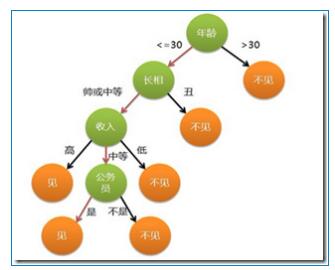功能描述:
聯(lián)系:highspeedlogic
QQ :1224848052
微信:HuangL1121
郵箱:1224848052@qq.com
網(wǎng)站:http://www.mat7lab.com/
網(wǎng)站:http://www.hslogic.com/
微信掃一掃:

function test_targets = ID3(train_patterns, train_targets, test_patterns, params)
% Classify using Quinlan's ID3 algorithm
% Inputs:
% train_patterns - Train patterns
% train_targets - Train targets
% test_patterns - Test patterns
% params - [Number of bins for the data, Percentage of incorrectly assigned samples at a node]
%
% Outputs
% test_targets - Predicted targets
[Ni, M] = size(train_patterns);
%Get parameters
[Nbins, inc_node] = process_params(params);
inc_node = inc_node*M/100;
%First, bin the data and the decision region data
[H, binned_train_patterns, region] = high_histogram(train_patterns, Nbins);
[H, binned_test_patterns] = high_histogram(test_patterns, Nbins, region);
%Build the tree recursively
disp('Building tree')
tree = make_tree(binned_train_patterns, train_targets, inc_node, Nbins);
%Classifying test patterns according to the tree
disp('Classifying test patterns using the tree')
test_targets = use_tree(binned_test_patterns, 1:size(test_patterns,2), tree, Nbins, unique(train_targets));
%END
function targets = use_tree(patterns, indices, tree, Nbins, Uc)
%Classify recursively using a tree
targets = zeros(1, size(patterns,2));
if (isempty(indices))
return;
end
if ((size(patterns,1) == 1) | (tree.split_dim == 0)),
%Only one dimension left, so work on it
for i = 1:Nbins,
in = indices(find(patterns(indices) == i));
if ~isempty(in),
if isfinite(tree.child(i)),
targets(in) = tree.child(i);
else
%No data was found in the training set for this bin, so choose it randomally
n = 1 + floor(rand(1)*length(Uc));
targets(in) = Uc(n);
end
end
end
return
end
%This is not the last level of the tree, so:
%First, find the dimension we are to work on
dim = tree.split_dim;
dims= find(~ismember(1:size(patterns,1), dim));
%And classify according to it
for i = 1:Nbins,
in = indices(find(patterns(dim, indices) == i));
targets = targets + use_tree(patterns(dims, :), in, tree.child(i), Nbins, Uc);
end
%END use_tree
function tree = make_tree(patterns, targets, inc_node, Nbins)
%Build a tree recursively
[Ni, L] = size(patterns);
Uc = unique(targets);
%When to stop: If the dimension is one or the number of examples is small
if ((Ni == 1) | (inc_node > L)),
%Compute the children non-recursively
for i = 1:Nbins,
tree.split_dim = 0;
if ~isempty(targets)
indices = find(targets == i);
if ~isempty(indices),
if (length(unique(targets(indices))) == 1),
tree.child(i) = targets(indices(1));
else
H = hist(targets(indices), Uc);
[m, T] = max(H);
tree.child(i) = Uc(T);
end
else
tree.child(i) = inf;
end
else
tree.child(i) = inf;
end
end
return
end
%Compute the node's I
for i = 1:length(Uc),
Pnode(i) = length(find(targets == Uc(i))) / L;
end
Inode = -sum(Pnode.*log(Pnode)/log(2));
%For each dimension, compute the gain ratio impurity
delta_Ib = zeros(1, Ni);
P = zeros(length(Uc), Nbins);
for i = 1:Ni,
for j = 1:length(Uc),
for k = 1:Nbins,
indices = find((targets == Uc(j)) & (patterns(i,:) == k));
P(j,k) = length(indices);
end
end
Pk = sum(P);
P = P/L;
Pk = Pk/sum(Pk);
info = sum(-P.*log(eps+P)/log(2));
delta_Ib(i) = (Inode-sum(Pk.*info))/-sum(Pk.*log(eps+Pk)/log(2));
end
%Find the dimension minimizing delta_Ib
[m, dim] = max(delta_Ib);
%Split along the 'dim' dimension
tree.split_dim = dim;
dims = find(~ismember(1:Ni, dim));
for i = 1:Nbins,
indices = find(patterns(dim, :) == i);
tree.child(i) = make_tree(patterns(dims, indices), targets(indices), inc_node, Nbins);
end
|





